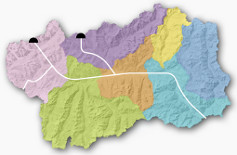The lower Lys Valley: from Pont-Saint-Martin to Fontainemore
How: by car.
Recommended duration: one day.
Recommended period: all year round.
Length: about 18 km.
An itinerary to discover the lower part of the Lys Valley, ancient domain of the lords of Vallaise between Piedmont and the Aosta Valley.
At Pont-Saint-Martin which the first village that you encounter when you enter the Aosta Valley, you should visit the Roman bridge, it is 36.65 metres long and 5.82 metres wide and dates back to the 1st century B.C.. In February, the village holds a historical carnival which reproposes the ancient legend of the ‘Devil’s bridge’ and that of the ‘Nymph of the Lys river’, with historical events that witnessed the conflict between the Salassi and the Romans to gain control over the region. By going up in the direction of Perloz, you will reach the old cemetery of Fontaney with the annexed chapel that was built on the orders of Baron Pierre de Vallaise during the late 16th century as a reproduction, on a small scale, of Aosta Cathedral. Along the road rises up the elegant Baraing Castle, which was built in the late 19th century in neo-Gothic style and has recently been restored. It is currently the headquarters of the Mountain Community. Going on for about a kilometre, after the park area Bousc-daré, you can appreciate the remains of the Pont-Saint-Martin Castle, which is also known as Castellaccio or Castello vecchio (Old Castle), whose original keep (donjon) dates back to the 11th century with subsequent additions and reconstructions that can be dated between the 13th and the 14th centuries.
Following the regional road to Gressoney-Saint-Jean (hamlet of Ivéry, hamlet of Holay) you can reach the Holay Pond Nature Reserve.
At Perloz you can admire the Sanctuary of Notre-Dame-de-la-Garde, which dates back to the 12th century and within the hamlet you can admire some interesting buildings that belonged to nobles and were built between the 14th and 15th centuries, including Vallaise Castle and Charles Castle. Just outside the administrative centre, in the hamlet of Tour d’Héréraz, stands the tower of Héréraz, the only evidence of the original castle that bore the same name and which now has been transformed into the bell tower of the village parish church. In the hamlets, which cannot be reached by car, interesting examples of rural architecture stand out, such as rascards (old wooden houses), mills, chapels and bridges. In mid-July in Perloz a rye bread making competition is held called Fehta dou pan ner (Black bread celebration).
At Perloz you can also visit:
- the Museum of the Resistance Movement – The museum is dedicated to the 3rd Lys Brigade and is located in the Lys Brigade building of the administrative centre. The collection includes some relics of the Partisan Brigade and various documents that have been donated, as well as meticulous historical research. The mule track between the villages of Plan de Brun and Marine was used during the Second World War by Nazi-Fascists looking for partisans of the Lys Brigade. During the repeated actions of retaliation it was indicated as the ‘Chemin de la liberté’ (Path of Freedom). The visit can be booked by calling the Town Hall: tel. (+39) 0125.807974 (from Monday to Friday)
- the exibition L'École d’autrefois (School in days gone ) set up in the attic of the old school of Marine displays furniture, objects and documents of a schoolroom from the early 1900s. Bookings can be made by calling the Town Hall: tel. (+39) 0125 807974 (from Monday to Friday)
- the Moulin des Glacières is an old restored mill in which one can see the old millstone and visit the rooms where the bread was made. Bookings can be made by calling the Town Hall: tel. (+39) 0125 807974 (from Monday to Friday)
- ‘Le Chemin de la Vallaise’ (Vallaise Path), a route of medium difficulty that last about an hour, from the hamlet of Perloz to Tour d’Héréraz, along which one can admire the constructions that that best illustrate the history of this community and its lords.
- The route of the ‘Grehe’ (or ‘Gra’) - Perloz and Lillianes: an itinerary that allows one to see 8 ‘Grehe’ (or ‘Gra’ for the Lys Valley), two-story buildings once used for drying chestnuts, partly within villages and in part on their boundaries. The ‘Gra’ which can be seen are located in three different hamlets of Perloz (Marine, Miocha and Derbellé) and in the same number of villages of Lillianes. To visit the inside of these buildings, please contact the Town Hall tel (+39) 0125 807974 (from Monday to Friday).
From Perloz one can take the road that goes up into the Gressoney Valley.
The first municipality that one comes across is Lillianes, which boasts a charming stone bridge from the late eighteenth century, the only example with four arches in the Aosta Valley which connects the inhabited centre to the parish church of San Rocco, which was built in the 17th century on the remains of an ealier chapel from the fifteenth century. In the centre of the hamlet there is an old fountain and a wash house encased in coarse stonework arch structures.
Continuing along the regional road one arrives at Fontainemore. There are two theories for the origin of its name: according to the first, it derives from an old fountain called ‘Fontaine de Saint-Maur’,(Fountain of Saint Maur) the other version recounts that the presence of arsenic in the water transformed the name of this spring into ‘Fontaine de la mort’ (Fountain of Death). When you enter the village, one’s attention is captured by the late Medieval bridge that bridges the River Lys with a single span measuring 22 metres. Of interest is the Church of Saint Anthony, for the valuable entrance portal in carved wood, the presbytery with a semicircular apse from the 15th century and the ribbed vault with the emblem of the Vallaise family; in the village you will also find the Visitor Centre of the Mont Mars Nature Reserve, which is the largest in the region. In the territory of this municipality lies the natural boundary between the Latin world (franco-provençal) and the German world (walser), marked by the Guillemore Ravine, which indicated the clear separation between the district of the Vallaise and those of Issime and of Gressoney, and which consists of a deep and narrow cleft in the rock where the Lys river falls in a cascade: a dam collects the water that is channeled and brought to the water station of Pont-Saint-Martin. From the bridge which connects the two banks of the river, the ravine can be admired in all its spectacular beauty.
At Fontainemore:
- The Mont Mars Nature Reserve is characterised by a subalpine and alpine landscape in a very natural setting with woods alternating with pastures and alpine meadows, stone quarries and rock faces, lakes and wetlands. At the Visitor Centre of the Mont Mars Reserve in località Capoluogo, you can visit the exhibition ‘La fauna della Riserva del Mont Mars e la processione di Oropa’ (The fauna of the Mont Mars Reserve and the procession of Oropa) and book guided excursions through the Reserve itself (tel. (+39) 0125 832700 or (+39) 0125 832121 (the latter number is available from Monday to Friday).
- The Mid Mountain Ecomuseum - Loc. Pra dou Sas – an absolutely beautiful mid-mountain village on the doorstep of the Mont Mars Nature Reserve, whose buildings have been partly set up as a living museum. For information and bookings, please contact the Visitor Centre: tel. (+39) 0125 832700 or (+39) 0125 832121 ( the latter number is available from Monday to Friday)
- The geological garden Le pietre del Lys (the stones of the Lys) , which is located within the grassy area on the banks of the Lys river. It is made up of nine displays with new types of different rocks than can be observed and touched. Furthermore, they are illustrated with interpretation panels in two languages. For information please call the Visitor Centre (tel. (+39) 0125 832700) or the Town Hall tel. (+39) 0125 832121 (the latter number is available from Monday to Friday).
- The mill and the bread oven of the village of Farettaz: the mill is now running for educational purposes with a small impoundment basin, while in the bread oven (which is still fully functional after having been restored) the equipment used in the past are kept. For information and bookings, please contact the Visitor Centre (tel. (+39) 0125 832700 or the Town Hall (+39) 0125 832121 (the latter number is available from Monday to Friday).













